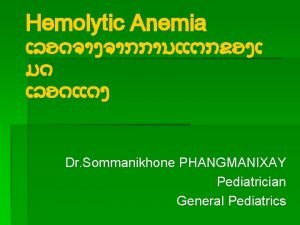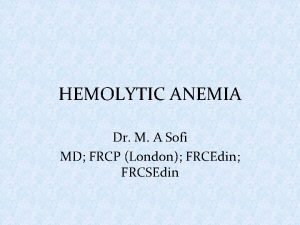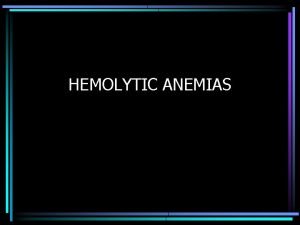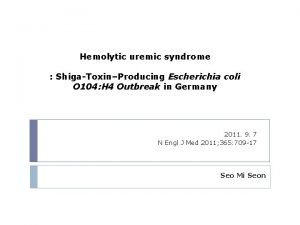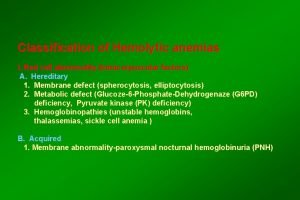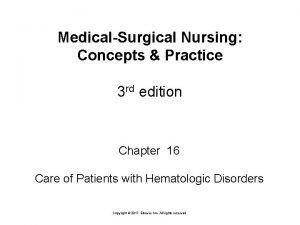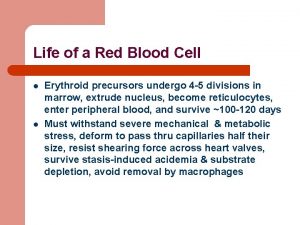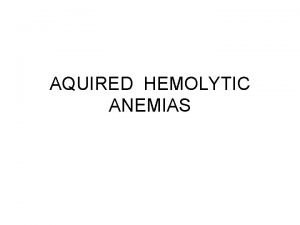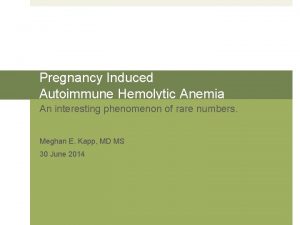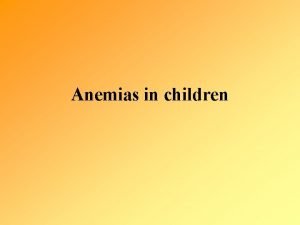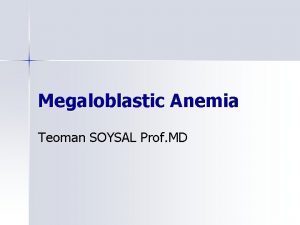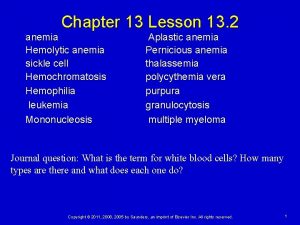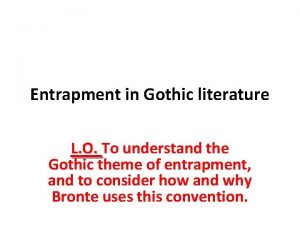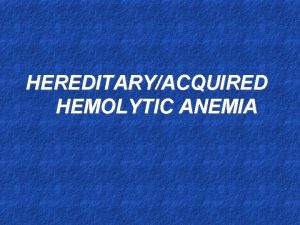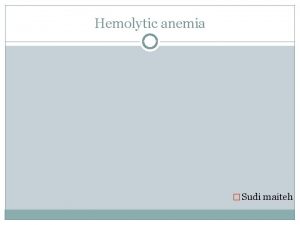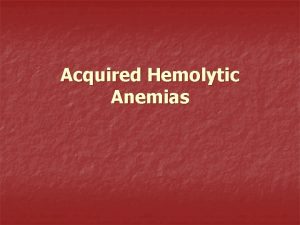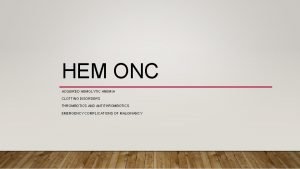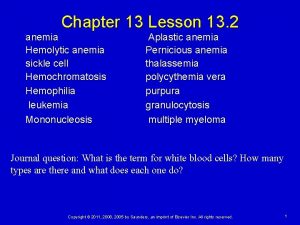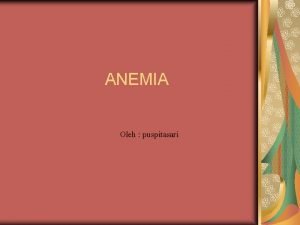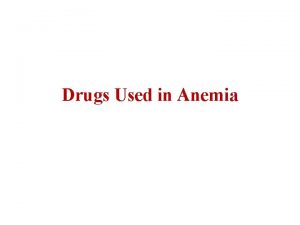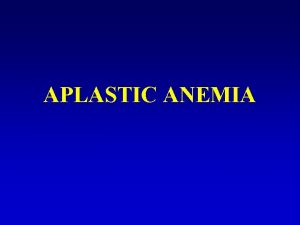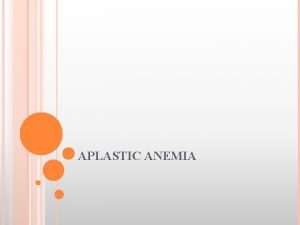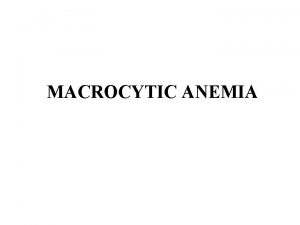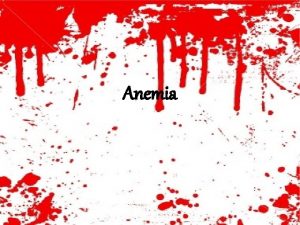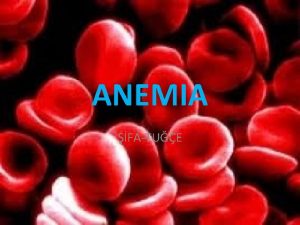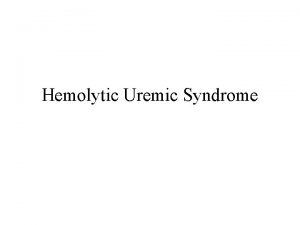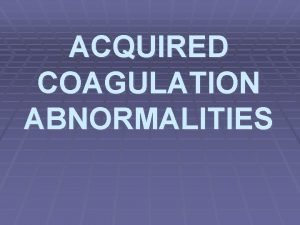Causes of acquired hemolytic anemia Entrapment Immune WarmreactiveIg





















- Slides: 21


Causes of acquired hemolytic anemia • • • Entrapment Immune – – Warm-reactive(Ig. G) antibody Cold-reactive Ig. M antibody (cold agglutinin disease) Cold-reactive Ig. G antibody (paroxysmal cold hemoglobinuria) Drug-dependent antibody • Autoimmune • Haptene Traumatic hemolytic anemia – Impact hemolysis – Macrovascular defects – prostheses – Microvascular causes • Thrombotic thrombocytopenic purpura/hemolytic-uremic syndrome • Other causes of microvascular abnormalities • Disseminated intravascular hemolysis Hemolytic anemia due to toxic effects on the membrane – Spur cell hemolytic anemia – External toxins • Animal or spider bites • Metals (e. g. , copper) • Organic compounds Paroxysmal nocturnal hemoglobinuria

IMMUNE HEMOLYTIC ANMEIA • Warm-reactive antibody (Ig. G) • Cold-reactive Ig. M antibody (cold agglutinin disease) • Cold-reactive Ig. G antibody (PCH) • Drug-dependent antibody 1. Autoimmune 2. Haptene

Hemolysis due to antibodies Warm-antibody immunohemolytic anemia • • Idiopathic Lymphomas: Chronic lymphocytic leukemia, non-Hodgkin’s lymphomas, Hodgkin’s disease (infrequent) SLE and other collagen-vascular diseases Drugs – Alpha-Methyldopa type (autoantibody to Rh antigens) – Penicillin type (stable hapten) – Quinidine type (unstable hapten) • • Postviral infections Other tumors (rare) Cold-antibody immunohemolytic anemia • Cold agglutinin disease – Acute: mycoplasma infection, infectious mononucleosis – Chronic: idiopathic, lymphoma • Paroxysmal cold hemoglobinuria

Figure 41 -01 Copyright © 2005 Elsevier Inc. (USA) All rights reserved.



IMMUNE HEMOLYTIC ANEMIA Warm Cold agglutinin Age Young Older Sex Female > male Male > female Hemolysis Extravascular Intra and/or extravascular Antibody Optimal temperature 37 o. C 4 o. C Immunoglobulin Ig. G Ig. M C' fixation no yes Coombs' reaction Ig. G yes no Complement no or yes Therapy Corticosteroid 60% benefit usually no Splenectomy 60% benefit no Immunosuppressive agents probable benefit Avoidance of cold no benefit








Disturbances of the formed elements of blood secondary to intravascular trauma Etiology Fragments Hemolysis Impact: march hemoglobinuria, karate, playing bongo drums, etc. Cardiac (turbulence): Aortic valve prosthesis ++++ Ostium primum repair ++++ Mitral valve prosthesis ++ ++ Calcific aortic stenosis + ± Vessel disease* +++ + + Thrombotic thrombocytopenic purpura Hemolytic uremic syndrome ++++ Disseminated intravascular coagulation Thrombocytopenia 0 ++++ ± ++++ 0 0 ++++ ++ ++++ * Malignant hypertension, Eclampsia, Renal graft rejection, Hemangiomas, Immune disease (scleroderma)




Acquired Hemoglobin Abnormalities: Methemoglobinemia • dominantly inherited abnormality (hemoglobin M) • recessively inherited deficiency of enzyme (methemoglobin reductase) • exposure to drugs or chemicals nitrites, xylocaine, benzene derivatives – life-threatening if > 30 -40% is methemoglobin: methylene blue 1 -2 mg/Kg infusion

Acquired Hemoglobin Abnormalities: Sulfhemoglobinemia • drugs like sulfonamide • disappear spontaneously Carboxyhemoglobinemia • Impairs delivery of oxygen • cherry-red color • faulty heaters, smokers
 Acquired hemolytic anemia
Acquired hemolytic anemia What causes hemolytic anemia
What causes hemolytic anemia Anmeia
Anmeia Types of hemolytic anemia
Types of hemolytic anemia Primary immune response and secondary immune response
Primary immune response and secondary immune response Microangiopathic hemolytic anemia
Microangiopathic hemolytic anemia Intravascular hemolytic anemia
Intravascular hemolytic anemia Why splenomegaly in hemolytic anemia
Why splenomegaly in hemolytic anemia Pathogenesis of hemolytic anemia
Pathogenesis of hemolytic anemia Extrinsic hemolytic anemia
Extrinsic hemolytic anemia Extracorpuscular hemolysis
Extracorpuscular hemolysis Coombs test for hemolytic anemia
Coombs test for hemolytic anemia Microangiopathic hemolytic anemia
Microangiopathic hemolytic anemia Hemolysis treatment
Hemolysis treatment Extrinsic hemolytic anemia
Extrinsic hemolytic anemia Acquired dyserythropoietic anemia
Acquired dyserythropoietic anemia Pernicious anemia vs megaloblastic anemia
Pernicious anemia vs megaloblastic anemia Megaloblastic anemia vs pernicious anemia
Megaloblastic anemia vs pernicious anemia Pernicious anemia symptoms
Pernicious anemia symptoms Popliteal entrapment syndrome
Popliteal entrapment syndrome Theme of entrapment
Theme of entrapment What is entrapment
What is entrapment
